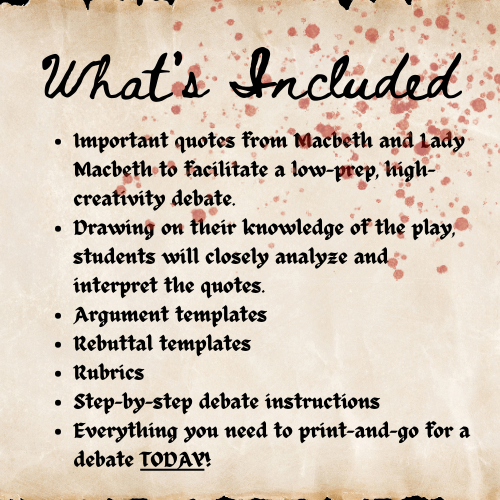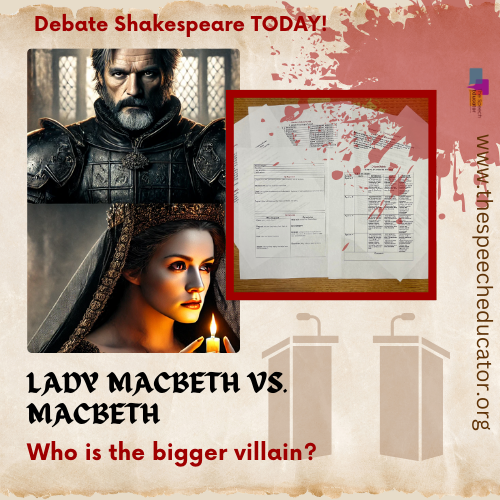Check out this resource on my TpT store!
I remember the first time I was assigned Macbeth in school and thinking, well, at least it’s short! I love Shakespeare now, and I remember what drew me in all those years ago was the complexity of the characters. But how do we best unmask these rich characters in the classroom? Two of which are Lady Macbeth and Macbeth– both villains in their own right– but if we had to pick one, which one should truly wear the crown of evil? Turning this key question from Macbeth into a lively classroom debate not only makes the content more accessible but also adds a layer of excitement to the learning process.
Overview of the Activity
In this debate-, students are asked to take sides on a provocative question: Who is the bigger villain, Macbeth or Lady Macbeth? The debate is not just about expressing opinions; it’s about using the knowledge they already have of the play to unpack and analyze the quotations that have been provided. It’s effectively a quotation test without the test. This approach encourages students to dive deep into the text, analyzing the language, motivations, and actions of the characters to build a compelling argument.
Preparing for the Debate
The activity begins with the class being divided into teams, with each team assigned to either defend Macbeth or Lady Macbeth as the more villainous character. This division fosters a sense of camaraderie as students collaborate (conspire?) to prepare their arguments. Each student is required to use quotations from the provided quote sheet, and nothing else, which ensures that their arguments are grounded in the text. This also ensures direct rebuttals later, as there is no outside information to account for. This not only helps students to focus on key moments in the play but also reinforces the importance of textual evidence in building a persuasive argument.
To prepare, students are given time to closely analyze their assigned character, using the provided quotes to craft their arguments. Each student must come up with a unique argument, teams must work together to certify that no two teammates present the same points or use the same quotations. This aspect of the activity encourages a thorough exploration of the text and creative analysis as students must think critically about how each quote supports their argument.
The Debate
Once preparation is complete, the debate begins. Each student delivers a one-minute speech, presenting their argument in defense of their character. The structure of the debate requires each student to not only present their argument but also prepare a rebuttal (on the provided rebuttal template) to counter their opponent’s points. This aspect of the activity adds a dynamic element, as students must listen carefully to their opponents and respond effectively, using additional quotes and analysis.
Conclusion
The “Villainous Debates: Macbeth vs. Lady Macbeth” activity is more than just a fun classroom exercise—it’s a powerful tool for deepening students’ engagement with Shakespeare’s Macbeth. By turning the analysis of the play into a debate, students are encouraged to explore the text in a way that is both rigorous and enjoyable. Let the villainous debates begin!



